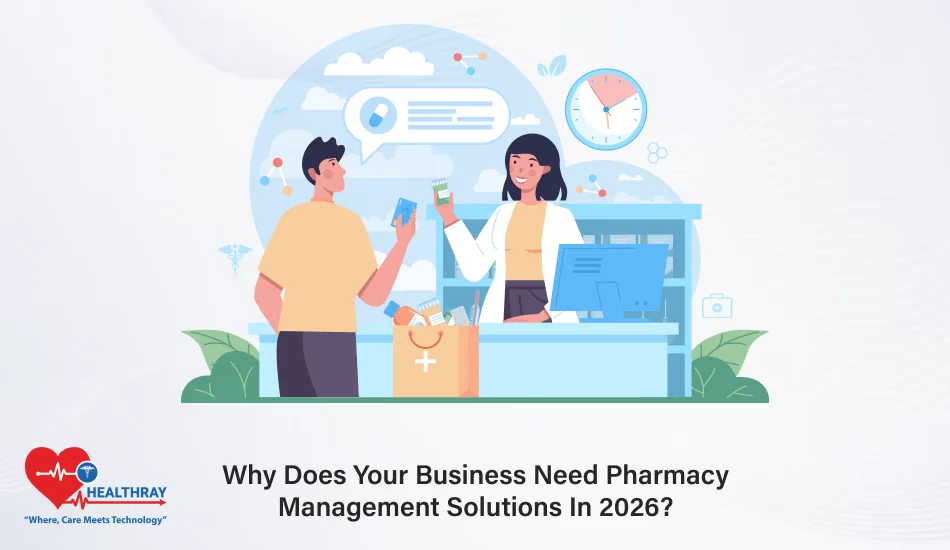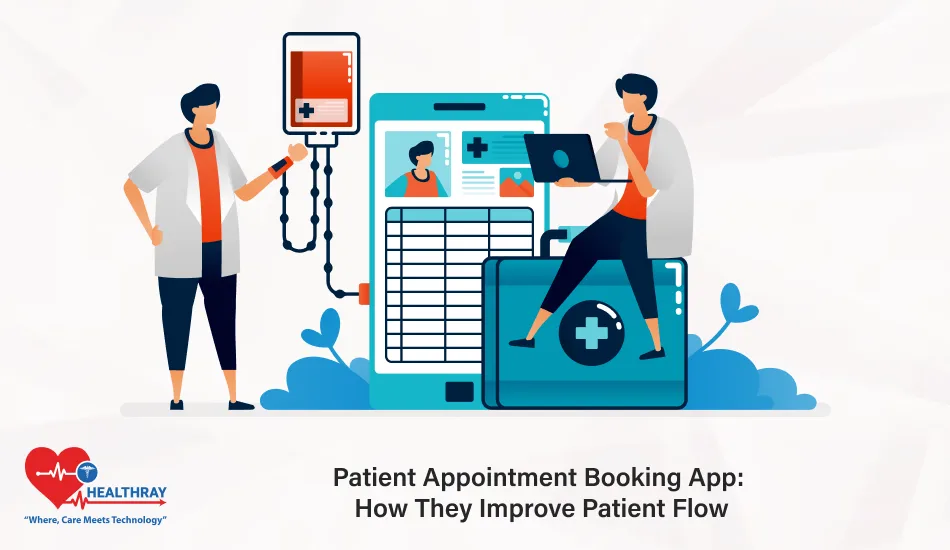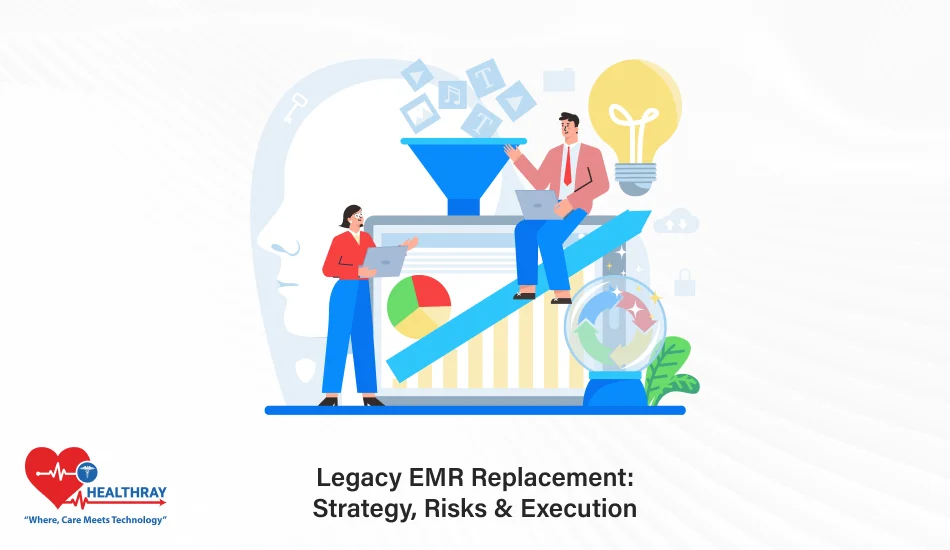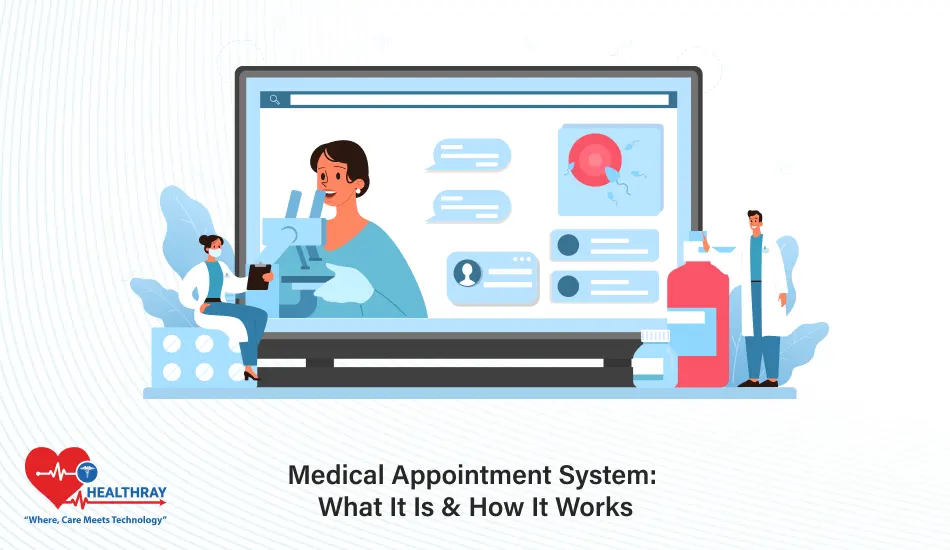The pharmacy landscape in 2026 is in a constant flux, with patients’ needs fast becoming complex, regulations getting stricter, and competition growing extremely fierce. To stay on top, businesses must grow and evolve, and this is where professional management solutions come in.
Pharmacy management solutions not only include simple inventory management. The pharmacy management system employs automation, artificial intelligence, and telepharmacy functions to allow clear-cut processes, increased accuracy, and improved patient care. Knowing how to use such tools allows pharmacies to operate smoothly, lower operational costs, and remain compliant with the changing healthcare laws.
This blog post will touch on the advantages of a pharmacy management system, what features it ought to have, and how one can arm itself by such means against the challenges of tomorrow. Additionally, pharmacy technology in the future would also be discussed, along with how these tools can give a sound footing for the success of your business.
The Key Features of Pharmacy Management Solutions

A pharmacy management solution is geared toward the myriad of issues facing pharmacies in modern settings. These are not just systems for boosting productivity; they are also systems for intervening in how pharmacies conduct business and deliver care. Here are some unique features of these systems:
Automation and Robotics
Manual inventory management is prone to errors and inefficiencies. Pharmacy management solutions integrate automated systems to perform such functions as stock tracking, expiration monitoring, and replenishment. In addition, dispensing prescriptions can be done by robots, speeding up the process and allowing pharmacists to spend more time on patients.
AI and Machine Learning Integration
Artificial intelligence is a game changer for pharmacy operations. The systems analyze historical data to predict inventory needs, optimize workflows, and personalize patient care. For instance, AI can flag abnormal prescribing patterns, allowing pharmacies to protect against patient harm and maintain regulatory compliance.
Telepharmacy Capabilities
Telepharmacy is no longer a futuristic trend but rather a necessity. Pharmacy management solutions provide remote consultations, prescription handling, and medication delivery services. All these functionalities are particularly helpful in rural or disadvantaged areas, thus helping bridge the gaps in healthcare access.
Customizable Reporting and Analytics
Data is power, and these systems provide easy access. They come with dashboards and reporting that allow pharmacies to observe trends, identify areas of inefficiencies, and make decisions based on data. Whether being used to analyze sales performance or to monitor compliance, it lends useful insight.
User-Friendly Interfaces
No matter how powerful a system may be, its interface is its Achilles’ heel. Modern pharmacy management solutions come with intuitive interfaces, thus allowing for easy adjustment by the teams. Features such as drag-and-drop workflows and guided processes are effective in minimizing training time while ensuring a smooth transition.
All these features go beyond just improving their operations by ensuring that pharmacies will soon get up to par with 2026 and beyond. This way, businesses will always find themselves ahead of industry trends so they can focus on what truly matters at the end of the day: giving their patients nothing but the best care.
Integration with Existing Systems
One of the biggest obstacles to the implementation of any new pharmacy management solution is the ability to integrate it into the structure of existing technologies. Pharmacies are somewhere in between with all sorts of mixed systems or merging systems while using others for inventory management, costing, and patient records. Hence, compatibility must be considered very seriously. Luckily, today’s solutions are architected with that ability in mind.
Integration with Electronic Health Record (EHR)
EHR systems are glued together to patient care themselves. Pharmacy management solutions establish a direct link with EHR platforms for instantaneous sharing of patient prescriptions, medical history, and allergies. This ultimately yields a reduction in errors, increases coordination among health providers, and further enhances patient safety.
Cross-Platform Interoperability
Pharmacies rarely ever work in isolation. Many work in joint operation with hospitals, clinics, and insurance companies. A strong pharmacy management solution, offering interoperability, allows the transfer of data across platforms. Such information flows make for an easy claim process and increased efficacy.
Customization Through API Intervention
API is what makes it possible for customization. By linking different software tools via APIs, pharmacies might be able to mold solutions that suit their precise requirements. For example, APIs can link inventory systems with automated ordering platforms such that stock levels are kept optimally without any human intervention.
Streamlined Billing and Insurance Processing
The integration with billing and insurance systems cuts down the admin work. The pharmacy management solution helps automated claims submission, tracking payment statuses, and flagging discrepancies. This enhances the rate of reimbursement and lessens revenue leakage.
Data Migration Support
Switching to a new system can indeed be an overhead task, especially with years of legacy data to deal with. Many Pharmacy Management Software have data migration tools in place that will smoothen the transition of records while safeguarding against data loss or corruption. Therefore, it will ease the entire migration process.
By focusing on integration, pharmacy management solutions obliterate silos and create a singular ecosystem. Interoperability not only creates operational efficiency work but also upgrades the customer experience; call it mutually beneficial, one for the business, the other for the patient.
Cost Implications and ROI
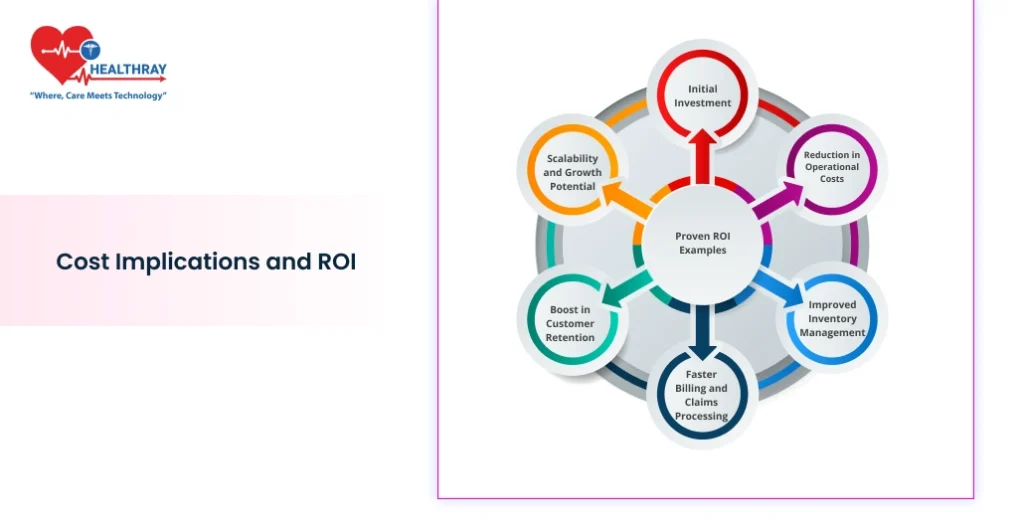
[Choose the right pharmacy management system] – while pharmacy management systems may seem like a financial burden, the operational and financial payoffs over a longer term far outweigh the initial implementation costs. Let’s go through the cost implications and the expected returns on investment (R.O.I.) that businesses are likely to see.
Initial Investment
This usually includes software licensing, hardware (if it is needed), plus implementation costs. Cloud solutions are subscription-based, so they spread the costs over time and are more manageable. On-premise systems can require larger capital investments upfront, but they also allow greater flexibility in controlling data.
Reduction in Operational Costs
With things like inventory management, billing and compliance tracking being automated, less time and money are needed. Pharmacies can thereby put less manual labor to more strategic uses and save on costs like payroll and damage payments.
Better Inventory Management
Wasting money can either be through keeping unneeded medications or having to do without essential ones. Pharmacy management systems look into inventory trends and automate restocking to reduce wastage while keeping stock levels optimal. This would alone result in saving several thousands of dollars every year.
Faster Billing and Claims Processing
When aging claims arise, cash flow is affected. Billing through these systems eases the claims process, thus allowing pharmacies to reduce denials and boost their revenue cycles. The system keeps track of unpaid invoices, which will ensure no money is lost.
Increased Customer Retention
Satisfied customers come back. These systems reduce waiting time, ensure prescriptions are correct, and provide added services such as telepharmacy, thereby improving the overall customer experience. An increase in retention translates to consistent revenue increase.
Scalability and Business Growth
Such scalable solutions allow businesses to gear up for future extension. Whether by adding more branches, extending the services, or increasing the number of patients handled, management systems in pharmacies allow for scalability without huge additional investments.
Proven ROI Examples
Studies show that advanced management systems for pharmacies deliver an ROI in 12 to 18 months. Examples include:
1. One midsized pharmacy saved 20% in labor costs by automating inventory and dispensing.
2. One pharmacy recovered thousands in lost revenue annually by reducing billing errors by 30%.
Costs will, of course, vary depending upon the particular system and the scale of implementation, but the very real financial gain, improved efficiency, and competitive edge would certainly make pharmacy management solutions worth their expense.
Regulatory Compliance and Data Security
Pharmacies belong to a business environment that is highly regulated and compliance is a constant challenge with ever-changing laws. Pharmaceutical management solutions thus become the enablers of such businesses while securing patient data. Let us see how they address such critical areas:
Automated Compliance Monitoring
Keeping up with regulatory updates is time-consuming, but these systems minimize the burden. The most recent updates are automatically applied in accordance with the new requirements of the healthcare regulatory framework, whether in regard to medication tracking or prescription standards. Essentially, your pharmacy remains compliant without needing manual compliance tracking.
Audit-Ready Documentation
There will be audits of pharmacies, and a poor response to those audits will incur penalties. The stores keep systematic records from their inventory logs, and all the way to the patient prescriptions. Such easy organization facilitates an audit and adversely affects some fines.
HIPAA and GDPR Compliance
The lifeblood of pharmacy operations is patient data, and therefore HIV (Health Insurance Portability and Accountability Act) and GDPR (General Data Protection Regulation) compliance is paramount. Pharmacy management solutions secure all forms of patient information through encryption and make this patient information unbreachable.
Access Control and User Permissions
These systems allow pharmacies to assign role-based access to employees. Sensitive information is accessible only to authorized personnel, reducing the risk of internal data misuse. This layered security approach strengthens overall data protection.
Real-Time Incident Alerts
The system sends alerts in real time when suspected security breaches or compliance concerns arise. This ensures that managers in pharmacies will deal with an incident quickly, which will minimize damages and support continuity.
Data Backups and Recovery
Accidents do happen: system failure, cyber-attacks, etc. Pharmacy management solutions include an automatic backup of data and recovery processes, ensuring that no critical information has been lost. Protecting business continuity alongside these processes will help win patient trust.
Regular Security Audits
Regular security audits are performed for most systems by the provider. This ensures that, at any time, the technology is updated with the latest security options and safeguards sensitive information.
By merging compliance automation with security solutions, pharmacy management solutions decrease the risks associated with laws and data breaches. This imparts peace of mind and gives pharmacies the ability to prioritize patient care instead of constantly worrying about legal or security concerns.
Implementation Challenges and Solutions
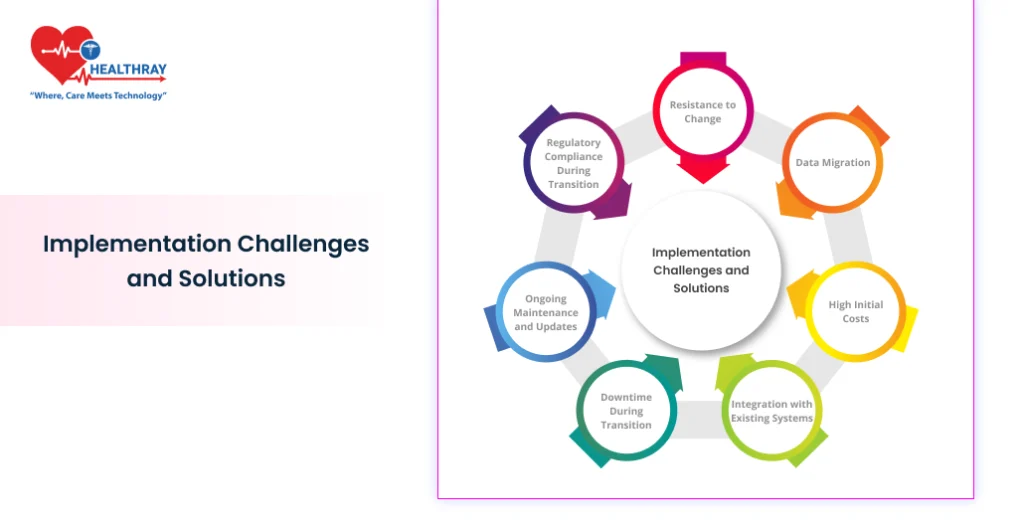
Sometimes implementing a new pharmacy system feels like a long and tedious process. From training of staff to integration of systems and data, challenges will be faced. Yet the entire implementation would go a lot more smoothly if these impediments and their solutions existed in the thoughts of the implementers in advance.
Resistance to Change
You may find that many members of staff resist the transition, fearing disruption to their working habits or even increasing workload.
Solution: Make it a point to involve employees early in the decision-making process. It is favored that training occurs in hands-on workshops so that they get the feel of the system. This is a big advantage for them, showing how the solution will ease their own daily activities, reduce timeframes, and minimize stress.
Data Migration
Moving years of patient records and inventory data into a new system can be daunting. To make things worse, there always exists the possibility of losing data, or corrupting it.
Solution: Choose software that creates robust tools for data migration. Many companies are able to offer migration support services, assuring all records are to be transferred securely and accurately. It is prudent to test the system with a smaller subset of data before a larger-scale migration is done.
High Starting Expenses
The initial cost of purchasing and implementing a system can seem high, especially to small pharmacy owners.
Solution: Seek subscription-based pricing models or negotiate with the provider a phased payment scheme. Ensure the financial model provided to stakeholders emphasizes long-term savings and ROI such that the initial investment can be justified.
Integration with Existing Systems
It can often turn into a technical obstacle to obtain compatibility with current software/hardware.
Solution: Opt for pharmacy management solutions applying more open APIs and seamless
integration capabilities. Let the provider carry out compatibility testing with the current system before full deployment.
Downtime During Transition
A temporary shutdown in daily operations may occur with a switch to the new system resulting in delays in service.
Solution: Plan for implementation during low activity hours or just go for a thorough phased rollout. Maintain plans to resolve any unforeseen issues so that patients are minimally affected.
Maintenance and Updates After Transition
Putting a system in place is actually the easiest part. Maintaining it and keeping it updated without getting appropriate support is quite a task.
Solution: Choose a provider that provides good customer support and a sound mechanism for regular updates. Pick up a cloud-based solution, if available, as the Provider generally looks after the updates from you with minimum efforts.
Regulatory Compliance During Transition
Pharmacist responsibilities for compliance do not cease during system conversion. Inadequate record maintenance during transition gives rise to heavy penalties.
Solution: Ensure that from day one, your new system facilitates real-time compliance monitoring. Always backup all relevant records so that nothing is lost during the conversion process.
This systematic approach to handling challenges will create an easy environment for implementation in pharmacies. The choice of a good solution from a supportive partner remains the crux of the matter.
Future Trends and Innovations in Pharmacy Management Solutions
The pharmacy industry is rapidly changing, with technology influencing the future. To be ahead, we need not only to implement existing solutions but also to look toward the upcoming trends and innovations. Here’s the outlook for pharmacy management solutions in 2026 and beyond.
Artificial Intelligence (AI) Enhancements
AI will likely become more intuitive and ingrained into pharmacy systems. These systems can do predictive analysis not only for inventory but also for advanced analytics such as detecting patient health trends, suggesting personalized medication plans, and identifying potential drug interactions.
Blockchain for Enhanced Data Security
Blockchain technology provides a secure way to manage records and transaction data. Each blockchain provides a ledger for record keeping that cannot be manipulated. These ensure transparency while minimizing incidents of unauthorized retrieval.
Widening the Telepharmacy Arena
Telepharmacy will broaden even further as telehealth grows. Solutions will embrace more features ranging from virtual consultations, processing digital prescriptions, and even granting remote medication dispensing through smart devices.
IoT-Aided Smart Pharmacies
The Internet of Things (IoT) will give a twist to inventory management and improve patient interaction. Smart shelves fitted with IoT sensors will monitor stock levels in real-time, while connected devices would send automated alerts about medication use and refills.
Personalized Medicine Integration
Advances in genomics and personalized healthcare will see pharmacy management systems integrating tools for customizing treatments based on a patient’s genetic profile. In turn, this will drive the industry into producing more precise and highly effective therapies.
Cloud-First Solutions
Cloud-based systems will reign supreme today thanks to promises of infinite scalability, automatic updates, and access from anywhere. These incur lower on-site IT infrastructure requirements and lower acquisition costs, making them attractive for pharmacies across the spectrum.
Voice-Assisted Technologies
Voice recognition tools will find their way in, allowing retrieval of records, processing of prescriptions, and management of inventory through voice commands by pharmacists and staff alike for improved workflow.
Advanced Patient Engagement Tools
Solutions of the future will spend a disproportionate share of their focus on the patient experience. Features like automated reminders for refills, virtual health chat, and mobile apps for tracking adherence to medication will become the norm.
Predictive Analytics for Market Trends
Not just to predict inventory, but also market trends and patient demand will be predicted by pharmacies using predictive analytics. This will assist the firms in swiftly adapting to change in order to maintain competitiveness.
Sustainability-Focused Features
As sustainability will become a priority, green initiatives will include tools like digital prescriptions and other waste-reduction functionalities. These will aid pharmacies in reducing their carbon footprint.
To take on more responsibility, this puts the pharmacy ahead as an industry leader. Management systems that demonstrate foresight in their design are expected to guarantee success, along with survival, in a market that increasingly becomes competitive and interactive.
Conclusion
Pharmacy management systems are not merely optional but mandatory these days. The pharmaceutical industry is moving along, and those companies embracing these systems will stay compliant in the market, along with being customer-focused. These solutions assist in addressing today’s challenges and preparing for the future, from the automation of everyday tasks to integrating cutting-edge technology such as AI and telepharmacy.
Pharmacy management systems help with operational issues such as data security, regulatory compliance, and patient engagement. Such systems help pharmacies enhance their operations, improve care delivery, and build stronger patient relationships.
The Hospital Management System topography in the year 2026 will reward creativity and flexibility. Those who invest in the right solution now will be positioning their business to meet the challenges and opportunities of tomorrow. The leap needs to be taken.
